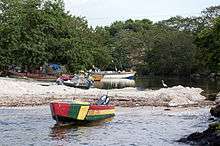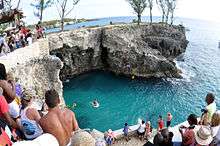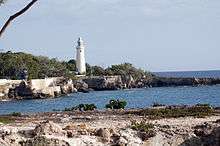Negril
| Negril | |
|---|---|
| Beach Resort | |
|
Negril coastline, with its famous beach in the background. | |
 Negril | |
| Coordinates: 18°18′40″N 78°20′22″W / 18.3110182°N 78.339386°WCoordinates: 18°18′40″N 78°20′22″W / 18.3110182°N 78.339386°W[1] | |
| Country | Jamaica |
| Parish | Westmoreland and Hanover |
| Time zone | EST (UTC-5) |
Negril is a small (pop. 6,900) but widely dispersed beach resort town located across parts of two Jamaican parishes, Westmoreland and Hanover.[2]
Negril is about an hour and fifteen minute drive on the coastal highway from Sir Donald Sangster International Airport, in Montego Bay. Westmoreland is the westernmost parish in Jamaica, located on the south side of the island. Downtown Negril, the West End cliff resorts to the south of downtown, and the southern portion of the so-called "seven mile (11 km) beach" are in Westmoreland. The northernmost resorts on the beach are in Hanover Parish. The nearest large town is Savanna-la-Mar, the capital of Westmoreland Parish.
History




The name Negril is a shortened version of Negrillo (Spanish: Little black ones), as it was originally named by the Spanish in 1494. The name is thought by some to be a reference to the black cliffs south of the village. Another theory holds that because there was a vast population of black eels along Negril's coast, the Spaniards called the area Anguila Negra which was shortened to Negrillo and then to Negril. Although Negril has a long history, it did not become well known until the second half of the twentieth century.[3]
Negril's development as a resort location began during the late 1950s, though access to the area proved difficult as ferries were required to drop off passengers in Negril Bay, forcing them to wade to shore. Most vacationers would rent rooms inside the homes of Jamaican families, or would pitch tents in their yards. Daniel Connell was the first person to create more traditional vacation lodging for these "flower children" when he set up the first guest house in Negril - Palm Grove. The area's welcoming and hospitable reputation grew over time and the first of many resorts was constructed in the mid to late 1960s. The first hotel in Negril was the Yacht Club by Mary's Bay on the West End.
When the road between Montego Bay and Negril was improved in the early 1970s, it helped to increase Negril's status as a new resort location. It was a two-lane paved road that ran approximately 100 yards (91 m) inland from two white coral sand beaches, at the southern end of which was a small village. The long paved road from the village ran north to Green Island, home to many of the Jamaican workers in Negril, and was straight enough to double as a runway for small airplanes, which was why there were lengths of railroad track standing on end along the side of the road - to discourage drug smugglers from landing on the road to pick up cheap cargos of marijuana.
After Negril's infrastructure was expanded—anticipating the growth of resorts and an expanding population, a small airport, the Negril Aerodrome, was built in 1976 near Rutland Point, alongside several small hotels mostly catering to the North American winter tourists. Europeans also came to Negril, and several hotels were built to cater directly to those guests.
Geography and ecology
The geography of Jamaica is diverse. The western coastline contains the island's finest beaches, stretching for more than 6 km (3.7 mi) along a sandbar at Negril. It is sometimes known among tourists as the "7-Mile Beach" although it is only slightly more than 4 mi (6.4 km) in length, from the Negril River on the south to Rutland Point on the north.
On the inland side of Negril's main road, to the east of the shore, lies a swamp called the Great Morass, through which runs the Negril River. Within the Great Morass is the Royal Palm Reserve, with protected wetlands and forest.
In 1990, the Negril Coral Reef Preservation Society was formed as a non-profit, non-governmental organization to address ongoing degradation of the coral reef ecosystem. The Negril Marine Park was officially declared on March 4, 1998 covering a total area of approximately 160 km2 (62 sq mi) and extending from the Davis Cove River in the Parish of Hanover to St. John’s Point in Westmoreland.
Scuba diving and snorkeling are especially good in the protected reef areas.
The West End Road is also known as Lighthouse Road as there is a Belgian engineered lighthouse protecting seafarers from the dramatic cliffs. There is beautiful scenery on this western tip of Negril, near Negril Lighthouse. You can mingle with locals at beer shacks like Sexy Rexy's and others "out West".
Negril today
For years, Negril's beach has been rated as one of the top ten beaches in the world by many travel magazines. The beach's length is the stuff of legends—it is actually little more than four miles in length, but tourists and travel writers insist on the "seven-mile" label. The north end of the beach is home to the large, all-inclusive resorts, and to the south are the smaller, family-run hotels. This combination gives the Negril area a large variety of rooms, services and prices.
South of downtown Negril is West End Road, known as the West End, which is lined with resorts that offer more privacy. These areas offer easy access to waters good for snorkelling and diving, with jumping points reaching more than 40 feet (12 m) high.
Many vendors and shops are located around the beach resorts; however, they are predominantly located on the south end of the beach, where there are fewer all inclusive resorts.
That Negril is still fairly underdeveloped remains a significant factor in its charm, but this may not last, as a new highway from Montego Bay and an improved infrastructure may bring more tourists. As a result, more hotels and tour operators continue to develop new attractions and excursions in Negril. Since the 1980s, it has also become a popular location for U.S. college students to visit during spring break or just a regular vacation in Jamaica.
The last few years have seen major development along the beach. The resorts include Couples Swept Away, Couples Negril, Sandals, Beaches, Samsara Hotel, Legends Resort, the Grand Lido, Riu Palace Tropical Bay, Riu Club Hotel and Hedonism II. The Hedonism II resort is one enduring hotel/resort that has been saved from bankruptcy and remains an adult destination. A franchise of Jimmy Buffett's chain restaurant and bar, Jimmy Buffett's Margaritaville, and a duty-free zone have also been added.
In recent years, a large development has been constructed consisting of ocean front villas, 2 or 3 bed townhouse developments and studio apartments. This development is known as Little Bay Country Club and is home to some of the wealthiest Jamaican families.
Currently under construction is the huge new Royalton Negril Resort.
Notable appearances in media
The early development of Negril as a resort is featured in Ian Fleming's 1965 novel The Man with the Golden Gun. One of the schemes of the novel's antagonist Francisco Scaramanga was to open a hotel called the "Thunderbird" on the beach.
Notable people
Author and activist B. Denham Jolly was born in Negril.[4]
See also
Resorts
- Beaches Resorts - Negril[5]
- Sandals Negril
- Little Bay Country Club (LBCC)
- Couples Swept Away
- Couples Negril
- Royalton Negril (under construction)
Notes
- ↑ "Wikimapia". Retrieved 2009-09-07.
- ↑ Negril Resorts
- ↑
- ↑ "Denham Jolly honoured". Jamaica Gleaner, Eddie Grant, March 8, 2012
- ↑ Beaches Resorts - Negril
References
- Banana Shout, (Fiction), by Mark Conklin, Fusion Press; 1st edition (March 2000). ISBN 1-928704-73-5
- Walk Good: Travels to Negril, Jamaica, (Nonfiction), by Roland Reimer, Trafford Publishing (July 12, 2006). ISBN 1-55369-871-1
- How Stella Got Her Groove Back, (Fiction), by Terry McMillan, Viking (1996). ISBN 0-670-86990-2
- The Naked Truth About Hedonism II, (Nonfiction), by Chris Santilli (last updated in paper July 2006). ISBN 978-0-9662683-3-1
- The Republic of Pirates, (Nonfiction), by Colin Woodward (2007). ISBN 978-0-15-603462-3
External links
| Wikimedia Commons has media related to Negril. |
| Wikivoyage has a travel guide for Negril. |
